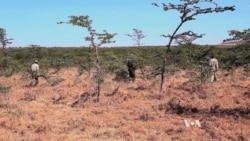In Laikipia, Kenyan rangers are driving game farther into a 36,000 hectare conservancy to protect the animals from conflict with encroaching humans. Wildlife officials use trucks and helicopters in the Ol Pejeta conservancy to protect game from being killed by locals either for food or protection.
Deep in the heart of the conservancy in Laikipia, rangers conduct a coordinated foot patrol. Ol Pejeta is East Africa’s Largest Black Rhino Sanctuary; it also borders 18 human communities.
To stop rising incidents of conflict between animals and the people living in the area, the rangers are herding game from the edges of the conservancy back into the expansive range.
Samuel Mutisya is part of the team coordinating this exercise - using foot patrols, 4x4s and a helicopter.
“We conduct game drives in such places where the fence is not high profile enough to prevent the animals from getting into the communities. And so basically we do this to drive animals from possible areas of conflict into the conservancy,” said Mutisya.
Surrounding local communities have been expanding into wildlife habitats. That means animals are being displaced from their natural territory and end up looking for food in populated areas.
As a result, locals lose crops, livestock and, sometimes, their lives. In 2013, 106 people were killed in the country by wild animals while 520 others were injured.
The animals are often killed in retaliation.
Willy Okoth commands 45 rangers at Ol Pejeta -- where he’s served for 15 years. He said a prolonged dry period this year has intensified animal-human conflict.
“At the moment there’s drought and it’s quite dry. This is the reason why the animals go off the conservancy and invade farms. So we conduct game drives so as to limit the number of animals that breach the boundaries and keep them in so as to maintain good relations with locals,” said Okoth.
The Kenyan government has an economic interest in protecting its wildlife, which attracts tourists and creates jobs.
Last year the government passed a law that compensates victims for loss of life or injury, as well as property damage caused by wildlife.
But as long as animals and people live side by side, conflict will remain a fact of life.






